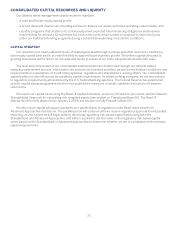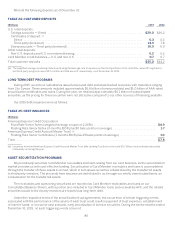American Express 2015 Annual Report Download - page 87
Download and view the complete annual report
Please find page 87 of the 2015 American Express annual report below. You can navigate through the pages in the report by either clicking on the pages listed below, or by using the keyword search tool below to find specific information within the annual report.
FULLY PHASED-IN BASEL III
Basel III, when fully phased-in, will require bank holding companies and their bank subsidiaries to maintain more
capital than prior requirements, with a greater emphasis on common equity. The following table presents our
estimates for our regulatory risk-based capital ratios and leverage ratios had Basel III been fully phased-in as of
December 31, 2015. These ratios are calculated using the Standardized Approach for determining risk-weighted
assets. As noted previously, we are currently taking steps toward Basel III Advanced Approaches implementation in
the United States. We believe the presentation of these ratios is helpful to investors by showing the impact of future
regulatory capital standards on our capital and leverage ratios.
TABLE 19: ESTIMATED FULLY PHASED-IN BASEL III CAPITAL AND LEVERAGE RATIOS
($ in Billions) December 31,
2015
Estimated Common Equity Tier 1 Ratio under Fully Phased-In Basel III (a) ............................ 11.8%
Estimated Tier 1 Capital Ratio under Fully Phased-In Basel III (a) .................................... 13.0
Estimated Tier 1 Leverage Ratio under Fully Phased-In Basel III (b) .................................. 11.2
Estimated Supplementary Leverage Ratio under Fully Phased-In Basel III ............................ 9.4%
Estimated Risk-Weighted Assets under Fully Phased-In Basel III (c) .................................. $135.0
Estimated Average Total Assets to calculate the Tier 1 Leverage Ratio (b) ............................ 156.0
Estimated Total Leverage Exposure to calculate SLR under Fully Phased-In Basel III (d) ................ $186.1
(a) The Fully Phased-in Basel III Common Equity Tier 1 and Tier 1 risk-based capital ratios, non-GAAP measures, are calculated as Common Equity
Tier 1 or Tier 1 capital under Fully Phased-in Basel III rules, as applicable, divided by risk-weighted assets under Fully Phased-in Basel III rules.
Refer to Table 20 for a reconciliation of Common Equity Tier 1 and Tier 1 capital under Fully Phased-in Basel III rules to Common Equity Tier 1
and Tier 1 capital under Transitional Basel III rules.
(b) The Fully Phased-in Basel III Tier 1 and supplementary leverage ratios, non-GAAP measures, are calculated by dividing Fully Phased-in Basel III
Tier 1 capital by our average total assets and Fully Phased-in total leverage exposure for supplementary leverage ratio purposes under Fully
Phased-in Basel III, respectively.
(c) Estimated Fully Phased-in Basel III risk-weighted assets, a non-GAAP measure, reflect our Basel III risk-weighted assets, with all transition
provisions fully phased in. This includes incremental risk weighting applied to deferred tax assets and significant investments in unconsolidated
financial institutions, as well as exposures to past due accounts, equities and sovereigns.
(d) Estimated Fully Phased-in Basel III Leverage Exposure, a non-GAAP measure, reflects average total consolidated assets with adjustments for
Tier 1 capital deductions on a fully phased-in basis, off-balance sheet derivatives, undrawn conditionally and unconditionally cancellable
commitments and other off-balance sheet liabilities.
The Basel capital standards establish minimum requirements for the Tier 1 risk-based capital ratios that are 1.5
percent higher than the minimum requirements for Common Equity Tier 1 risk-based capital ratios. This difference
between Tier 1 capital, which includes common equity and qualifying preferred securities and Common Equity Tier 1 is
also present in the minimum capital requirements within Comprehensive Capital Analysis and Review (CCAR). We
issued $750 million of preferred shares in the fourth quarter of 2014 and $850 million in the first quarter of 2015. The
preferred shares issuances help to finance a portion of the Tier 1 capital requirements in excess of common equity
requirements.
Our $750 million of subordinated debentures, which prior to 2014, were fully included in Tier 2 capital (but not in
Tier 1 capital), do not meet the requirements of Tier 2 capital under Basel III. The phase-out of the subordinated
debentures from Tier 2 capital began in the first quarter of 2014 and will be fully phased out on January 1, 2016, which
affects our total risk-based capital ratio. At our option, the subordinated debentures are redeemable for cash on or
after September 1, 2016 at 100 percent of the principal amount plus any accrued but unpaid interest. We currently
intend to exercise this redemption option, subject to business and market conditions. As previously mentioned, we
issued $600 million of subordinated notes in the fourth quarter of 2014, which qualifies as Tier 2 capital under Basel
rules. Our total risk-based capital ratio is expected to remain well in excess of the required minimum.
76
























